Honor Award
The Better Block Project
Dallas
SWA Group, Sausalito, CA and StreetSpace Collaborative
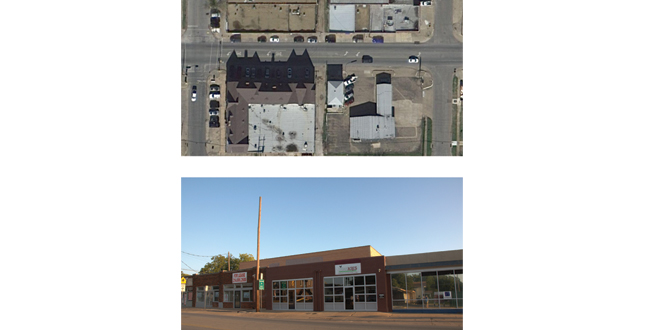 Close Me!
Close Me!Existing Site. In September 2010, local landscape architects and community activists formed a collaborative to develop a plan for The Better Block Project. The site chosen for the temporary intervention is located on a major vehicular artery of the Oak Cliff neighborhood. Despite the high visibility of these buildings, most of the retail spaces are currently for lease.
Download Hi-Res ImageImage: Jason Roberts, David Thompson
Image 1 of 16
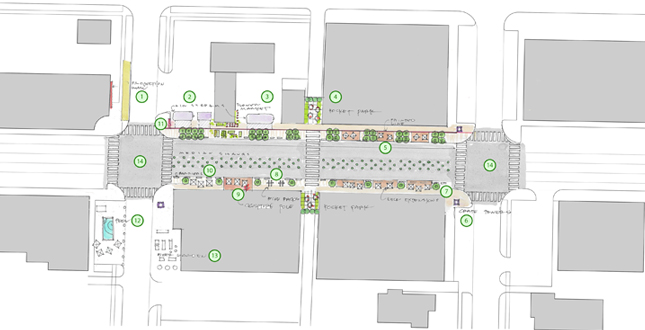 Close Me!
Close Me!With the assistance of community members, a plan of simple landscape improvements was constructed that could show the community an alternative future for this space. These improvements had to be constructed and removed in a single day.
Download Hi-Res ImageImage: Jason Roberts, David Thompson
Image 2 of 16
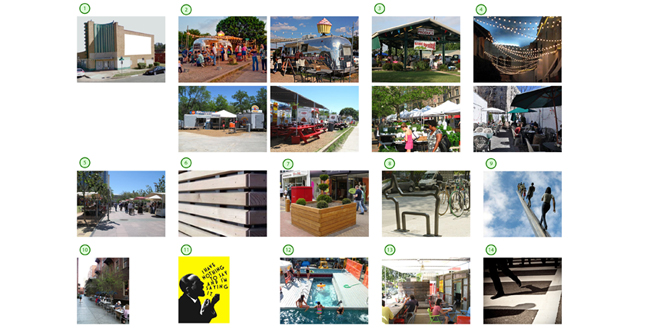 Close Me!
Close Me!Inspirational Images. Instead of providing detailed drawings for these improvements, images were provided to volunteers so that the ideas could be adapted and interpreted in ways that were both executable by the volunteers and meaningful to the community.
Download Hi-Res ImageImage: Jason Roberts, David Thompson
Image 3 of 16
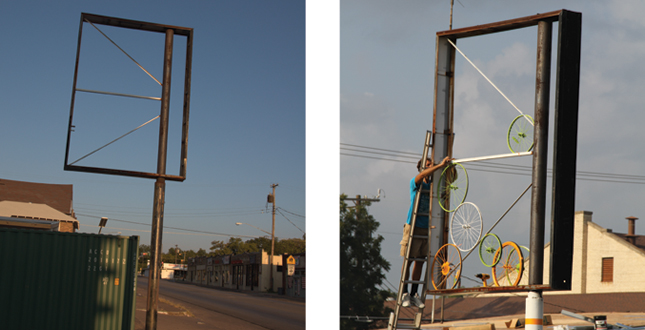 Close Me!
Close Me!Early the morning of the Better Blocks Event, volunteers started redefining this two block space. Existing empty business signage became an art piece commenting on bicycle awareness and alternate transportation modes.
Download Hi-Res ImageImage: Jason Roberts, David Thompson
Image 4 of 16
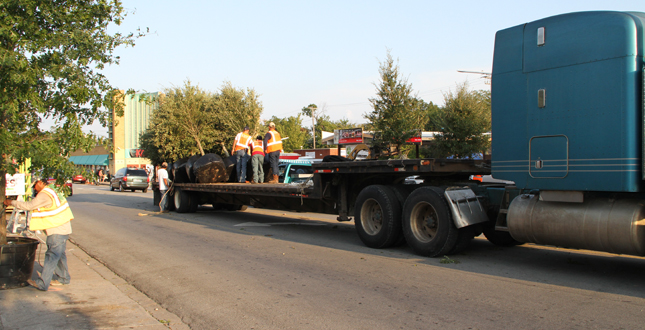 Close Me!
Close Me!The landscape architect coordinated with a landscape contractor to provide plant materials for the day. The temporary planting brought new vitality to the block by structuring the parking zones into smaller scale rooms for alternate uses.
Download Hi-Res ImageImage: Jason Roberts, David Thompson
Image 5 of 16
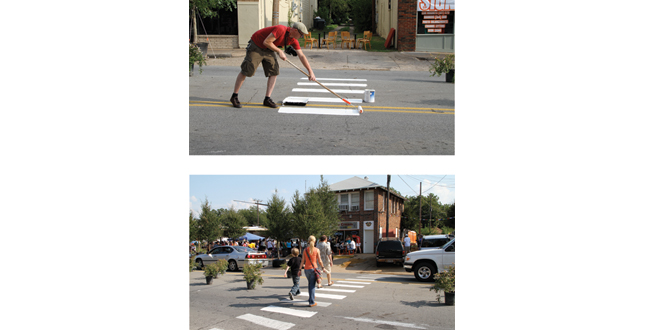 Close Me!
Close Me!Organizers took it upon themselves to improve the pedestrian infrastructure of the block by adding crosswalks where appropriate. The additional feeling of safety provided by these small gestures encouraged pedestrian traffic during the event.
Download Hi-Res ImageImage: Jason Roberts, David Thompson
Image 6 of 16
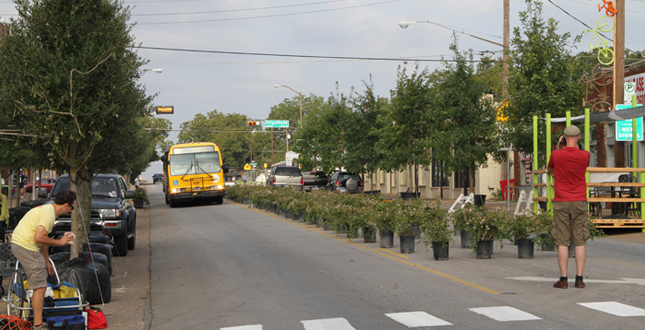 Close Me!
Close Me!The combination of these small design moves created a more intimate urban space. The finer grain created by and within each space allows for it to be meaningful at the speed of the car, the bike, or the pedestrian.
Download Hi-Res ImageImage: Jason Roberts, David Thompson
Image 7 of 16
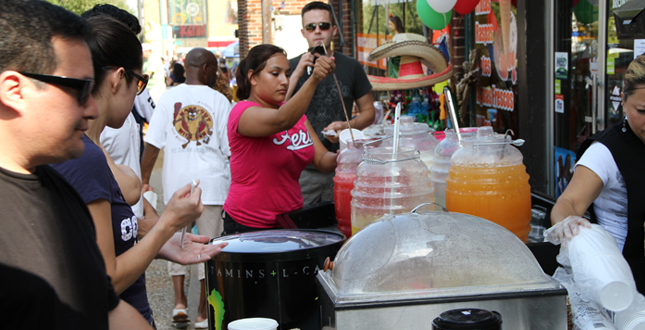 Close Me!
Close Me!The existing retailers along the block were encouraged to bring their wares out onto the sidewalk during the Better Blocks event. This brought activity into the general public space and highlighted the diversity of the neighborhood.
Download Hi-Res ImageImage: Jason Roberts, David Thompson
Image 8 of 16
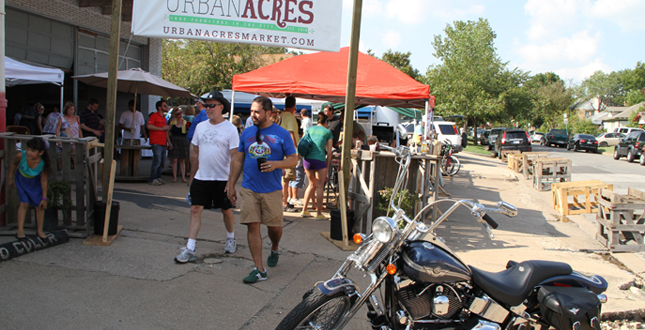 Close Me!
Close Me!A local business dedicated to promoting products that are sustainably created locally had an opportunity to show community members the diversity of products generated in the area as well as forge new relationships with local suppliers.
Download Hi-Res ImageImage: Jason Roberts, David Thompson
Image 9 of 16
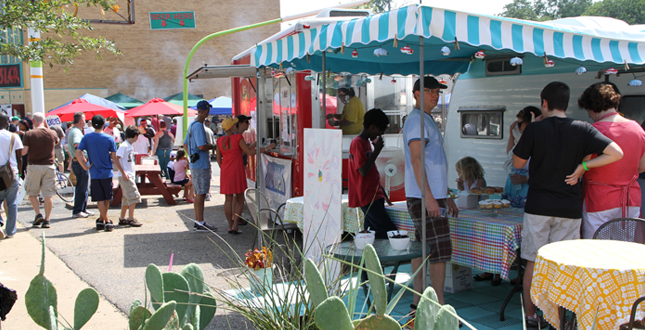 Close Me!
Close Me!Mobile food trucks were used to reinforce the street edge at existing surface parking lots. These were complemented by adjacent seating areas and other street-side vendors.
Download Hi-Res ImageImage: Jason Roberts, David Thompson
Image 10 of 16
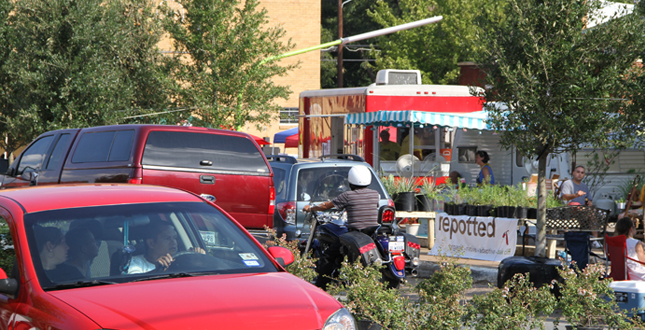 Close Me!
Close Me!The Better Block improvements calmed traffic by reclaiming some of the space previously dedicated to cars, adding activity at the street edge, and breaking down the scale of the infrastructural corridor to a human scale.
Download Hi-Res ImageImage: Jason Roberts, David Thompson
Image 11 of 16
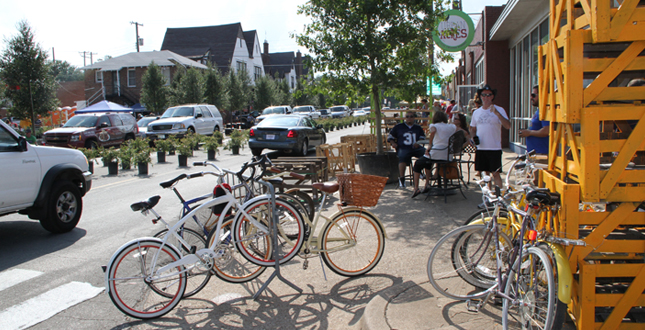 Close Me!
Close Me!The intervention supported multi-modal transportation by improving infrastructure for pedestrians and bicyclists.
Download Hi-Res ImageImage: Jason Roberts, David Thompson
Image 12 of 16
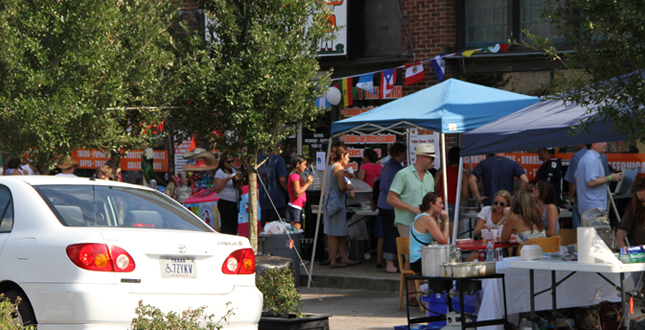 Close Me!
Close Me!By using planting to create places for people to gather along the street, the redesign improved the animation of the street edge.
Download Hi-Res ImageImage: Jason Roberts, David Thompson
Image 13 of 16
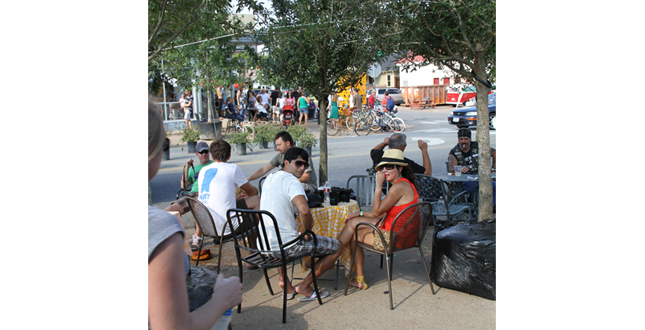 Close Me!
Close Me!Parking places for cars have become places for socializing and public engagement. Simple modifications made a large difference in the community’s enjoyment of the public space. Thousands of citizens from the neighborhood attended the event and were able to understand first-hand the value that these services and landscape improvements can create for the community.
Download Hi-Res ImageImage: Jason Roberts, David Thompson
Image 14 of 16
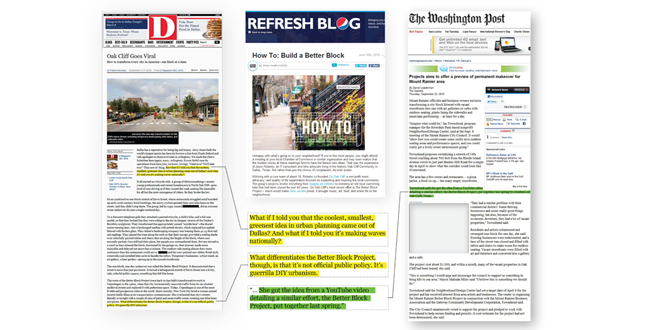 Close Me!
Close Me!The Better Block Project received widespread media attention and support from local civic leaders. The idea was feature in D Magazine, The Washington Post, Pepsi’s Refresh campaign, The League of American Bicyclists, Grist, Dallas Observer, Cooltown Studios, and GOOD Magazine.
Download Hi-Res ImageImage: Jason Roberts, David Thompson
Image 15 of 16
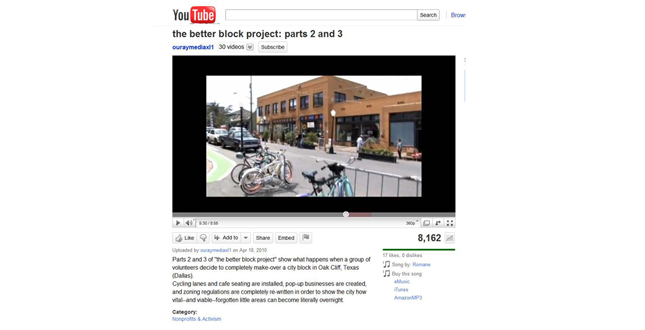 Close Me!
Close Me!The non-profit organization created two YouTube videos describing the Better Block project and filming the street before, during, and after the construction implementation. The media coverage and you tube videos prompted copycat block improvements throughout the country. New "Better Blocks" have been created in: Fort Worth, Texas; Mount Rainier, Maryland; Memphis, Tennessee; and even Oyster Bay, New York; where Billy Joel, inspired by YouTube videos of the original, underwrote a Better Block Project for his hometown.
Download Hi-Res ImageImage: Jason Roberts, David Thompson
Image 16 of 16
Project Statement
Over the past several decades, designers and city officials have struggled to create and maintain interest from local communities for long-term urban modifications. Images of an ideal future urban condition seem too distant and unachievable for many members of these communities. The Better Blocks Project illustrates how simple modifications can powerfully alter the economic, social, and ecological value of a city by gathering designers and community volunteers together to create a one-day urban intervention to spark the imagination and interest of citizens and leaders alike. The Better Blocks intervention addressed not just the design of our urban spaces but also the codes and ordinances that have become the de facto generator of urban form.
Project Narrative
—2011 Professional Awards Jury
In September 2010, local landscape architects and community activists formed a collaborative to develop a plan for The Better Block Project, a one day urban block transformation project set in Dallas, Texas. A simple set of interventions was proposed that could be constructed and removed in the course of a single day. Some of the interventions required coordination with a landscape contractor who donated plant material and labor, while others relied on the help of local artisans and community members who volunteered their time and talents. The final product combined a number of simple modifications to generate a big impact in the community’s overall enjoyment of the space.
An entire block was restructured and transformed by placing new rows of street trees and a “median” created of shrubs. The new open spaces created by these trees accommodated café seating and areas for vendors to sell their wares. Pedestrian activity was encouraged by painting new crosswalks and diverted automobile traffic through the area. Bicycling was encouraged and supported by creating new bike lanes and providing bike parking infrastructure. Local business owners with empty storefronts allowed for the creation of “pop-up” businesses for the event and temporary food stands filled in the gaps in the historic store frontages.
Oftentimes designers painstakingly craft images that capture the imagination of their clients. These images range in scale and complexity from hand-drawn sketches and diagrams to sophisticated 3-D animations and large-scale physical models. No matter how large or how sophisticated these creations may be, the goal is always the same – to give physical form and visually express an idea and excite the imaginations.
Sometimes, however, just crafting an image is not enough. Today design firms can create renderings that imitate photographs and animations that look like Hollywood special effects; however, city governments still face a challenge using these graphic tools to create the long-term interest required to implement “Vision” plans or “Comprehensive Planning” proposals in existing neighborhoods. Community members often view these images of an idealized urban environment with skepticism as these plans are perceived to be too expensive and too politically challenging to implement over the lengthy timelines required in most U.S. cities. No matter how compelling and persuasive design professionals and city officials find these images, they must acknowledge that what is convincing to them is not necessarily convincing to the community as a whole.
The Better Block Project broke down these typical barriers by communicating basic urban design and planning ideas in a completely new way – by building them and showing the community what could be changed through relatively simple urban design modifications. This project took a blighted block of an urban neighborhood and changed the space using some easily implemented design strategies. This one day event was an opportunity for members of the community and civic leaders to physically experience what these changes could mean for their neighborhood.
The Better Block Project went beyond simple urban “beautification” strategies and openly questioned outdated and overly-restrictive city ordinances that prohibit neighborhood amenities like fruit stands, sidewalk flora, sandwich boards, and more. The thousands of neighbors who attended the event experienced first-hand the value these services can provide for their community and asked city leaders at the event to reconsider some of the city’s antiquated ordinances. City leaders and staff who attended the event also began researching ways to make some of the changes permanent when community members asked how they could maintain the vitality of the temporary space.
The recognition the Better Block Project has received from media and local civic leaders has created copycat block improvements throughout the country. New “Better Blocks” have been created in: Fort Worth, Texas; Mount Rainier, Maryland; Memphis, Tennessee; and even Oyster Bay, New York, where Billy Joel, inspired by YouTube videos of the original, underwrote a Better Block Project for his hometown.
The Better Block Project successfully bypassed the standard long-range visioning and rendering model most commonly used in city governance by creating a physical experience that illustrated how relatively small investments in urban spaces and streets can vitalize a community. This temporary installation provided clarity on what changes needed to be made in the neighborhood by testing them with the public. This process replaced years of visioning, planning, community meetings, and more. This is not public policy. It’s guerilla urbanism that creates a new paradigm for urban planning communication and community involvement.
Project Resources
Lead Designer: David Thompson, ASLA
Jason Roberts
Chuck McDaniel, ASLA
Rob Rider
Andrew Howard
Amy Cowan
Zac Lytle
Malina Pearson
Leila Grothe
Jonathan Braddick
Gary Buckner
Matt Spillers
Pierrette LaCour
Jean Marie Browning
Kevin Nowell
Robert Sparks
Metheny Landscape Development
Shag Carpet
Square Foot






